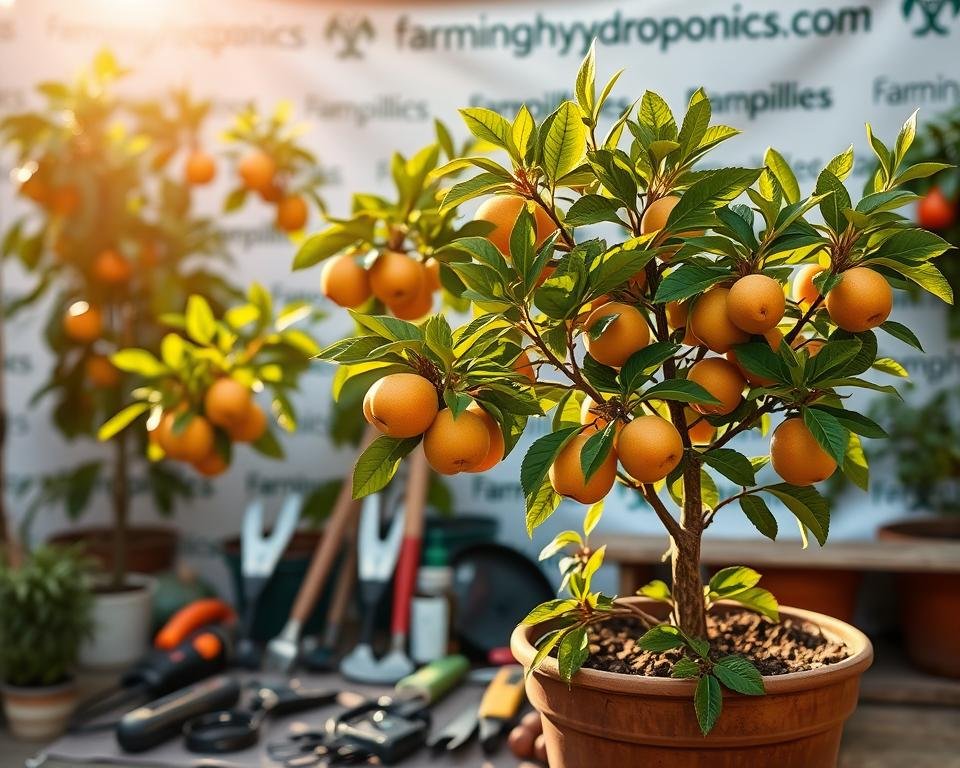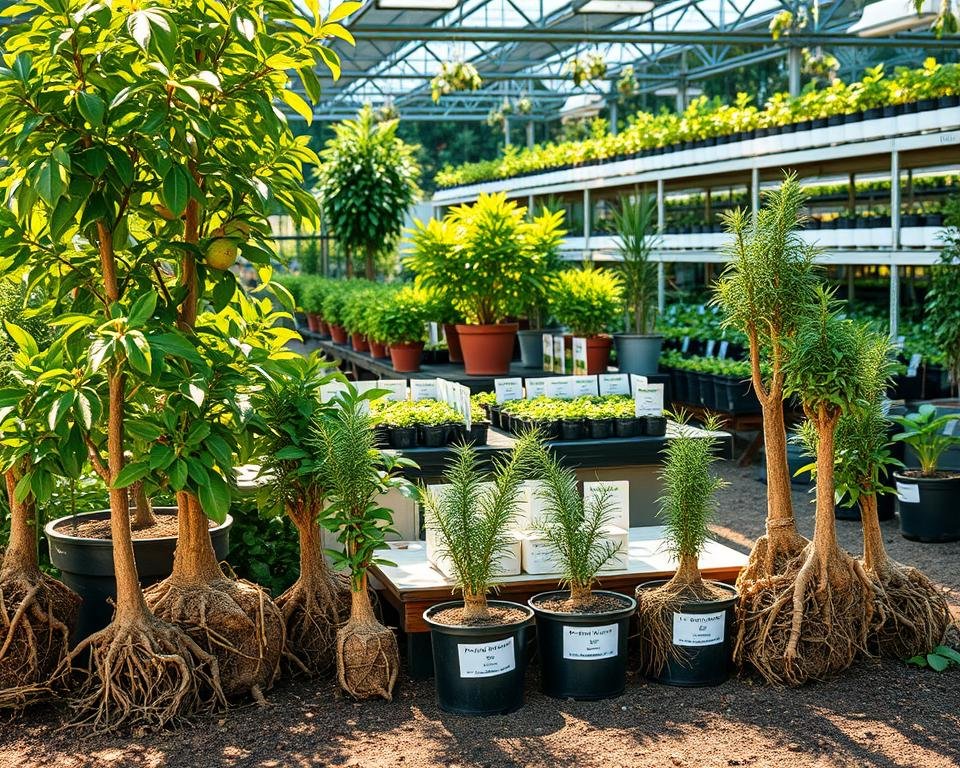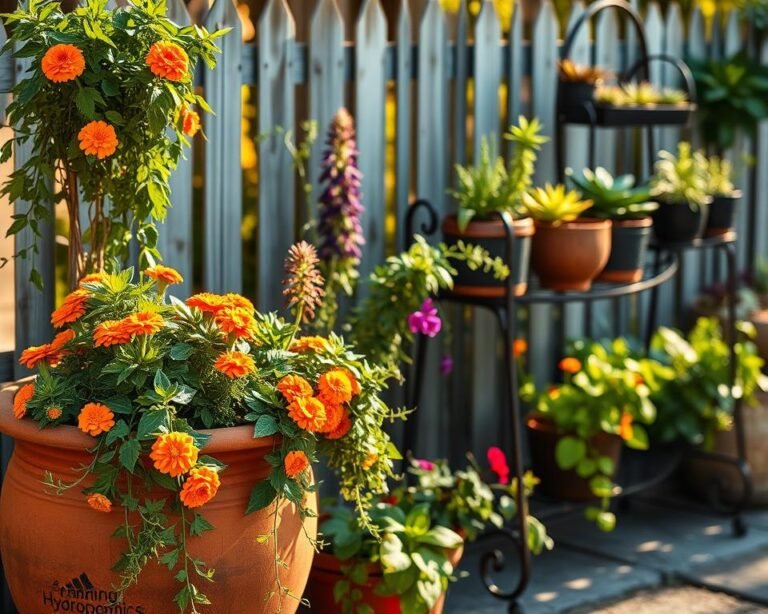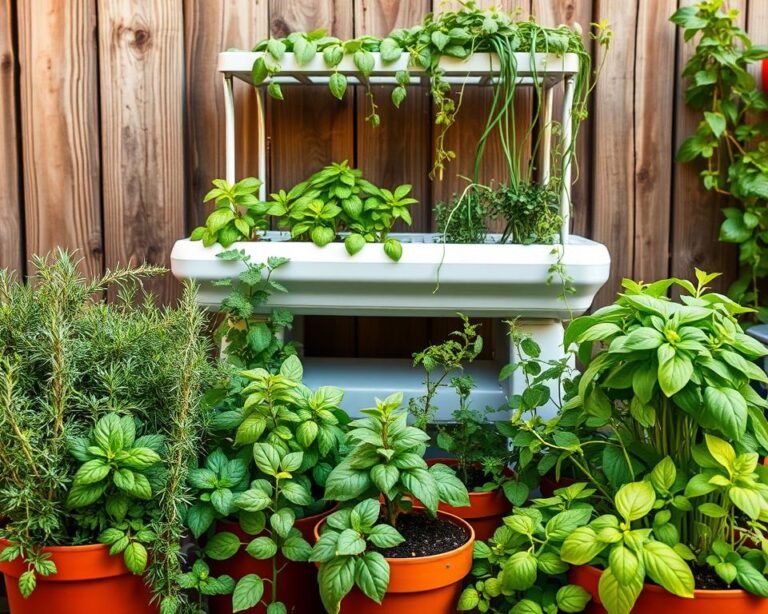Fruit Growing Tips for Container Gardens
Ever dreamed of picking fresh, juicy fruits from your patio or balcony? Container gardening makes this dream come true for city gardeners and those with small spaces. The secret to growing fruit in tiny areas is knowing how to make the most of every inch—and following the right fruit growing tips.
Urban garden fans are finding out how amazing container gardening is. With a few pots and some smart planning, you can grow tasty fruits in the smallest spots. Whether you have a tiny terrace, balcony, or small backyard, container gardening is a flexible way to enjoy fruits.
City folks don’t need big land to grow their own food anymore. Container gardening lets you control the growing conditions, move plants easily, and use every inch of your space. You can grow everything from strawberries to dwarf fruit trees in your small area, turning it into a fruit haven.
Key Takeaways
- Container gardening enables fruit production in limited spaces
- Urban gardeners can grow multiple fruit varieties in pots
- Flexible growing solutions work for balconies, patios, and small yards
- Control of growing conditions is easier in container environments
- Fruit growing requires minimal gardening experience
- Container methods can increase fruit yield per square foot
Understanding Container Fruit Growing Basics
Container fruit growing is a great option for those with little space. You can grow a mini orchard on a balcony or in a small backyard. The key is proper fruit tree care and container gardening techniques.
Benefits of Growing Fruit in Containers
Container fruit growing has many benefits:
- Maximum flexibility in plant placement
- Control over soil conditions
- Easy pest management
- Extended growing seasons
Space Requirements and Location Planning
For successful container fruit growing, planning is key. Sunlight exposure is crucial. Most fruit trees need 6-8 hours of direct sunlight a day. This ensures healthy growth and good pollination.
| Fruit Type | Minimum Container Size | Sunlight Requirement |
|---|---|---|
| Apple | 20-25 gallons | Full sun |
| Cherry | 15-20 gallons | 6-8 hours direct sun |
| Peach | 20-25 gallons | Full sun |
Suitable Fruits for Container Growing
Not all fruit trees are good for containers. Dwarf and semi-dwarf varieties are best. They are smaller and produce well. Some popular choices are:
- Dwarf apple trees
- Compact cherry varieties
- Miniature peach trees
- Compact citrus trees
By following these basics, you can turn small spaces into fruitful gardens. They will be beautiful and delicious.
Selecting the Right Containers and Soil

Starting a container garden is all about picking the right containers and soil. Urban garden lovers know that good soil is key to growing fruit. The type of container you choose affects your plants’ health and how well they grow.
When picking containers for your garden, think about these important points:
- Container size (5-20 gallons recommended)
- Material durability
- Drainage capabilities
- Weight and mobility
Here are some top container materials:
- Plastic: Lightweight and affordable
- Terracotta: Excellent moisture regulation
- Ceramic: Attractive and sturdy
- Fabric: Promotes air pruning of roots
Soil preparation is vital for a successful container garden. Don’t use regular garden soil, as it’s too heavy and can carry diseases. Instead, use a special potting mix that:
- Drains water well
- Is light
- Is full of nutrients
- Has a pH between 6.0-6.8
Studies show that using top-notch potting soil can boost fruit production by up to 25%. By choosing the best containers and soil mix, you’ll give your urban fruit garden the best chance to flourish.
Fruit Growing Tips and Essential Care Guidelines
Container fruit tree care needs special attention for healthy growth and plenty of fruit. Knowing the unique needs of fruit trees in small spaces is key. Fruit tree care involves mastering several critical techniques that differ from traditional ground planting.

Container-grown fruit trees need more frequent checks and precise care. Water drains quickly from containers, leading to faster nutrient loss than in gardens.
Watering Requirements and Techniques
Proper watering is crucial for container fruit trees. Your watering approach should focus on:
- Checking soil moisture daily
- Ensuring consistent hydration
- Avoiding waterlogging
- Using drainage-friendly containers
Fertilization Methods and Timing
Fertilization methods are key in container fruit growing. Organic fertilizers offer slow-release nutrients for strong tree growth. During active growing seasons, apply liquid fertilizer at least twice monthly, following product instructions carefully.
Pruning and Maintenance Strategies
Pruning techniques are essential for maintaining container fruit trees. Focus on:
- Removing dead or crossing branches
- Maintaining an open canopy
- Controlling tree size
- Encouraging fruit production
Early winter is the best time for pruning when trees are dormant. This approach promotes healthier growth and enhances fruit production potential.
Choosing Appropriate Rootstocks and Varieties
Choosing the right rootstock is key for growing fruit in containers. Rootstocks affect the size, vigor, and performance of fruit trees. In small spaces, knowing about rootstocks is crucial for orchard management.

Different fruits need specific rootstocks for container growing. Here are some top picks for various fruits:
- Apple trees:
- M26 (semi-dwarf): Ideal for containers and small spaces
- M27 (very dwarf): Excellent for compact gardens
- Cherry trees:
- Gisela 5 (dwarf): Perfect for container cultivation
- Colt (semi-vigorous): Suitable for larger containers
- Stone fruits:
- Pixy (dwarf): Great for plums, peaches, and nectarines
- St Julien A (semi-vigorous): Provides more robust growth
Grafting and budding let you mix the best of rootstocks and fruit varieties. Think about these points when choosing:
| Rootstock | Ultimate Height | Best Use |
|---|---|---|
| M9 | 2-2.5 meters | Small gardens, cordons |
| Gisela 5 | 2.5-3 meters | Trained trees, containers |
| Quince C | 2-5.3 meters | Pear trees, limited spaces |
“The right rootstock is the foundation of a successful fruit tree” – Orchard Experts
When picking a fruit tree, look for self-fertile varieties that thrive in small spaces. These trees can grow fruit without needing pollinators, making them great for container gardening.
Managing Pests and Diseases in Container Fruit Trees
Successful fruit tree care means being proactive about pests. Container fruit trees face many threats, from insects to diseases. Knowing these threats and using the right prevention methods can keep your plants healthy and fruitful.
It’s important to check your trees often for signs of trouble. Pests like scale, aphids, and mites can harm your trees quickly. Use organic solutions like neem oil or IV Organics Plant Guard spray to protect them. Look for pests on the underside of leaves and where branches meet the trunk.
To prevent diseases, keep your trees in the best conditions. Prune them to improve air flow and avoid crowding. Keep mulch and compost away from the trunk to stop fungal diseases. Potted trees need extra care in extreme weather, so protect them from heat and cold.
When harvesting, manage your plants carefully. Remove any fallen fruit or diseased parts right away to stop infections. Use white latex paint or tree guards to protect the trunk from sunburn and pests. With regular care and natural pest control, your container fruit trees will thrive and give you plenty of delicious fruit.







